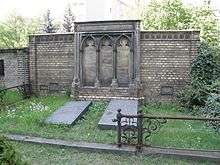Ernst March

Ernst March (born June 30, 1798 in Panknin , † December 14, 1847 in Charlottenburg ) was a German pottery manufacturer .
Life
Ernst March was born on June 30, 1798 in Panknin. After an apprenticeship as a potter in Tobias Feilner's furnace factory , he was its partner for a short time. In 1846, however, he founded his own company, the Marchsche Tonwarenfabrik on the Tiergartenfeld in Charlottenburg. The factory grounds with the manufacturing buildings and the residential building were on land that is now used as the northern campus of the Technical University of Berlin .
The manufactory initially produced simple industrial ceramics, including molds for the sugar industry, but since the beginning of the 1840s has specialized in terracotta and majolica production . March became the leading producer of terracotta, rivaling Feilner's factory. Feilner himself died in 1839. Friedrich August Stüler commissioned the terracottas for the St. Matthäikirche around 1844 and later embarked on new technical paths with the iron structures and vaults made of potted bricks from March's pottery factory when building the New Museum .

When the terracotta columns were burning for the atrium in the Paradiesgärtlein below the Orangery Castle in Potsdam, a work by Ludwig Persius , March 1846 worked because of the length of the columns in the drafty boiler house of the factory. In doing so, “he caught a cold that resulted in a kidney and lung disease degenerated ”, as his son Paul wrote in his memoirs. Ernst March died of the consequences of this illness.
After his early death in 1847, the widow Sophie March, née Keller, continued to manage the company. From 1865 their sons Paul and Emil continued to run the company as Ernst March & Söhne Tonwarenfabrik . She continued to produce high-quality terracottas for well-known and prestigious buildings such as the Berlin Museum of Decorative Arts , the Görlitzer Bahnhof or the Red Town Hall . The son Otto became an architect , as did the grandsons Walter and Werner March . Around 1896 the Ernst March & Sons factory employed 150 workers and consumed 1,500 tons of clay annually. In 1902 the factory merged with similar companies to form Deutsche Ton- und Steinzeugwerke AG ; the production in Charlottenburg was given up.
Ernst and Sophie March were buried in the Luisenfriedhof I in Berlin-Charlottenburg - near the factory site. Marchstrasse on the former company premises is named after Ernst March.
Selection of buildings with terracotta by the Ernst March & Sons pottery factory

- 1844/46 terracotta for the St. Matthäikirche , Berlin
- 1844 Terracotta group of children carrying bowls, canopy fountain near the obelisk portal, Sanssouci Park , Potsdam
- 1845/46 Twelve terracotta columns and 4 vases in the atrium of the Paradiesgärtlein, Potsdam
- between 1847 and 1851 Five terracotta muses, in the round niches of the south terrace at the mill house of the historical mill of Sanssouci
- around 1850 terracotta vases between the Corinthian columns at the gatehouse and sexton's house, Sanssouci Park
- around 1850 terracottas, potted bricks and floor coverings for the Neues Museum , Berlin
- between 1850 and 1861 female robe statue and amphorae made of terracotta, niches in the upper floor of the orangery castle (central building)
- 1854 terracotta for the university , Königsberg
- 1850/51 terracottas at the Triumphtor in Potsdam, together with the furnace factory Feilner & Comp.
- 1858–1860 terracottas at the entrance to the Borsigsche Maschinenbauanstalt on Chausseestrasse by Heinrich Strack . After the factory was closed in 1887, moved to the garden of the Technical University of Berlin in 1901
- 1861–1869 terracotta Red City Hall , Berlin
- 1866–1868 terracotta for the Görlitzer Bahnhof , Berlin
- 1876 Terracotta figure Germania (by Calandrelli ), griffins and relief on the war memorial 1870/71 in Güstrow
- 1877–1881 terracotta at the former arts and crafts museum, today's Martin-Gropius-Bau , Berlin
- around 1880 various terracotta figures for public spaces and as architecture in Radebeul by the Ziller brothers , a. a. the four seasons on Fontainenplatz on Dr.-Schmincke-Allee or the groups of figures at Sophienhof (former Sophienstrasse )
Web links
- The four seasons on the Dr.-Schmincke-Allee roundabout in Radebeul
- Information from the district office of Charlottenburg-Wilmersdorf on the March family.
- Product catalog, Berlin 1848, issue 1 , issue 2
Individual evidence
- ↑ Birgit Jochens, Herbert May: The cemeteries in Berlin-Charlottenburg . Stapp Verlag, Berlin 1994, ISBN 3-87776-056-2 .
- ↑ Marchstrasse. In: Street name lexicon of the Luisenstädtischer Bildungsverein (near Kaupert )
literature
- Hans-Henning Zabel: March, Ernst. In: New German Biography (NDB). Volume 16, Duncker & Humblot, Berlin 1990, ISBN 3-428-00197-4 , p. 109 f. ( Digitized version ).
| personal data | |
|---|---|
| SURNAME | March, Ernst |
| BRIEF DESCRIPTION | Pottery manufacturer |
| DATE OF BIRTH | June 30, 1798 |
| PLACE OF BIRTH | Panknin (Pomerania) |
| DATE OF DEATH | December 14, 1847 |
| Place of death | Charlottenburg |



